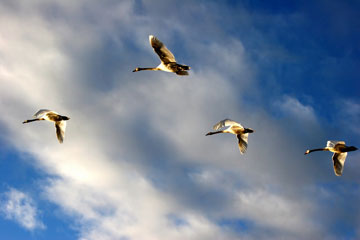 By Ned Rozell September 02, 2006
Larry Gedney, a former associate professor of geophysics at the Geophysical Institute who died in 1992, explored the question in this column over a decade ago. Gedney wrote of the myth that the lead goose was breaking trail for his flock-mates, much like a front-running bicycle racer allows teammates to decrease wind resistance by drafting directly behind. When the lead goose got pooped, he would give a honk and another would take his place at the tip of the V. But birds aren't bike riders. According to an article in Science, in a proper V all birds experience approximately the same amount of benefit from their neighbors. Although it doesn't seem plausible, even the leader at the tip of the formation benefits from the wind currents produced by the birds directly behind it. Pilots know the migrating birds' mechanism as the "wing tip vortex." The volume of air surrounding a bird must always remain the same, so when a bird displaces air downward on a wing beat, some air also must be displaced upward. This upward displacement of air creates an upwash beyond a bird's wing tips that enables the bird beside or behind it to fly with a bit less energy. Because the upwash is produced off a bird's wing tips, it might seem advantageous for birds to fly shoulder-to-shoulder like the offensive line of a football team. But, according to the Science article, such a formation would force the birds on the outside of the formation to work a lot harder than those flanked by birds on each side. Those with neighbors at both wing tips would enjoy twice the lift of those on the end of the line. The V formation ensures that some birds don't end up looking like bodybuilders while others cruise along in their wake. Researchers discovered that a flock of 25 birds in formation can fly 70 percent farther than a single bird using the same amount of energy. Stragglers who bust out of the V pay a price in increased air friction and a higher energy cost. For this reason, the system is self-stabilizing-even young birds who haven't migrated before quickly feel the advantages of flying in the V. Birds rarely make a perfect V in their migrations, but even a formation that looks like a large check mark is effective. The V-formation works as an energy-saver so long as the lead bird, at the apex of the V, has birds on both sides. If a lazy bird decided he wanted to tuck inside the V, he would indeed save energy. But he would do nothing to enhance the flight efficiency of the flock. Apparently, birds won't stand for malingerers in the flock, or the pattern would resemble a shotgun pattern more than a V. The researchers who presented the Science study also found that geese migrating by themselves fly 24 percent faster than a cruising flock. Gedney suggested the stragglers were frantically trying to make their way back to a flock in formation, where teamwork makes the yearly task of migration less of a drag. Publish A Letter on SitNews Read Letters/Opinions
|
||
